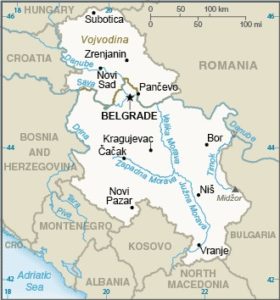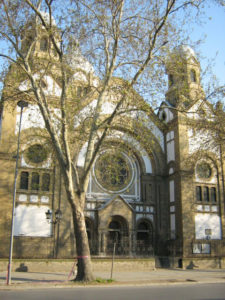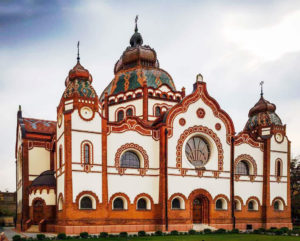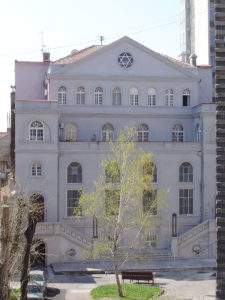 Serbia has a Jewish history that can be traced back to the 12th century. From the period of the 12th century C.E. until the mid-18th century, Jews in Serbia were generally treated well. They were traders mainly involved in selling salt. By the end of the Turkish rule over Serbia, Jewish tradesmen were largely responsible for the trade route between the northern and southern ends of the lands ruled by the Turks.
Serbia has a Jewish history that can be traced back to the 12th century. From the period of the 12th century C.E. until the mid-18th century, Jews in Serbia were generally treated well. They were traders mainly involved in selling salt. By the end of the Turkish rule over Serbia, Jewish tradesmen were largely responsible for the trade route between the northern and southern ends of the lands ruled by the Turks.
In 1804, the Serbs waged a war against the Turks for their independence. In response to the violent revolt, many Jews moved to Zemun and created their own community there. In support of the wars of independence, Jews supplied the Serbs with weapons, and in return, Jews faced brutal attacks by the Turks. The wars of independence lasted until 1830 when the Serbs gained the right to self-rule.
The new Serbian government was not as friendly in their relations with Jewish citizens. In fact, by 1831, the Serbs had already begun to prohibit Jews from certain professions. By 1845, the Serbian Jews had been prevented from participating in even the most basic of professions. There was a great deal of inconsistency in the laws regarding Jews to the end of the 19th century. The Subotica Synagogue, was built in 1902, and while its beauty remains, it is in need of major renovations.
 The Serbian parliament did not lift its restrictions on Jewish citizens until 1889. Because of blatant Serbian anti-Semitism, the Jewish population in the area decreased each year. In 1912, 5,000 Jews remained in Serbia. By 1941, the Jewish population in Serbia was approximately 12,000. While there was a long tradition of anti-Semitism throughout the republic, the Nazi regime brought with them an official decree against Jews. German troops occupied the city of Belgrade and began to destroy Jewish homes, stores, and synagogues. Jews were quickly forced to register and wear yellow identifying stars.
The Serbian parliament did not lift its restrictions on Jewish citizens until 1889. Because of blatant Serbian anti-Semitism, the Jewish population in the area decreased each year. In 1912, 5,000 Jews remained in Serbia. By 1941, the Jewish population in Serbia was approximately 12,000. While there was a long tradition of anti-Semitism throughout the republic, the Nazi regime brought with them an official decree against Jews. German troops occupied the city of Belgrade and began to destroy Jewish homes, stores, and synagogues. Jews were quickly forced to register and wear yellow identifying stars.
While it was at first sufficient to subject Serbian Jews to forced labor, by the end of the summer in 1941, the Nazis had sent 2,500 to a concentration camp outside Belgrade. 8,000 Jewish men who lived in and around Serbia were brought to this same concentration camp. It became clear that none of the Jews would be leaving the camp. Forty-five hundred of the prisoners were killed by gunfire between August and October of 1941. Serbia was the only country outside Poland and the Soviet Union where all Jewish victims were killed on the spot without deportation, and was the first country after Estonia to be declared “Judenfrei”, a term used by the Nazis during the Holocaust to denote an area free of all Jews.
 Dušan Jovanović, a retired professor of medial science, worked with the staff of a Novi Sad hospital during the Second World War to hide 20 Jews throughout 1944, and save their lives from Nazi persecution. He acted out of his sense of humanity, without expecting to ever be recognized or awarded, since he himself went through terrible ordeals. Others who saved Jews include: Andrija Latal, Petar Zanković, Klara Baić, and Ristić, Risto.
Dušan Jovanović, a retired professor of medial science, worked with the staff of a Novi Sad hospital during the Second World War to hide 20 Jews throughout 1944, and save their lives from Nazi persecution. He acted out of his sense of humanity, without expecting to ever be recognized or awarded, since he himself went through terrible ordeals. Others who saved Jews include: Andrija Latal, Petar Zanković, Klara Baić, and Ristić, Risto.
 The former Yugoslavia was liberated in 1944. Throughout the entire region, only 14,000 Jews returned. Those, who survived, did so in the Italian-occupied zone, in territories located within the borders of Bulgaria, Macedonia and Kosovo. Historians assume that several hundred Jews managed to hide within Serbia. They found refuge, especially those from Belgrade, in Toplica in southern Serbia, on the slopes of Kopaonik and Rudnik, as well as in villages in the eastern part of the country. The community, however wasted no time in trying to rebuild and the Federation of Jewish Communities was quickly opened. Many of the Jewish communities throughout Yugoslavia were reclaimed. Serbian civilians were involved in saving thousands of Yugoslavian Jews during this period and Yad Vashem recognizes 131 Serbians as Righteous Among Nations.
The former Yugoslavia was liberated in 1944. Throughout the entire region, only 14,000 Jews returned. Those, who survived, did so in the Italian-occupied zone, in territories located within the borders of Bulgaria, Macedonia and Kosovo. Historians assume that several hundred Jews managed to hide within Serbia. They found refuge, especially those from Belgrade, in Toplica in southern Serbia, on the slopes of Kopaonik and Rudnik, as well as in villages in the eastern part of the country. The community, however wasted no time in trying to rebuild and the Federation of Jewish Communities was quickly opened. Many of the Jewish communities throughout Yugoslavia were reclaimed. Serbian civilians were involved in saving thousands of Yugoslavian Jews during this period and Yad Vashem recognizes 131 Serbians as Righteous Among Nations.
In 1989, following the rise of Slobodon Milosevic to power, Yugoslavia’s republics began to violently break apart from each other. While the entire region became embroiled in war, the Jewish communities in particular were thrown into the middle of the situation. In 2003, the Republic was renamed Serbia and Montenegro.
 Currently, there are around 1,400 Jews living Serbia, with the majority based in the capital of Belgrade. The only remaining functioning synagogue in Serbia is the Belgrade Synagogue. For the first time ever, a permanent Chief Rabbi was appointed in Podgorica, the capital of Montenegro.
Currently, there are around 1,400 Jews living Serbia, with the majority based in the capital of Belgrade. The only remaining functioning synagogue in Serbia is the Belgrade Synagogue. For the first time ever, a permanent Chief Rabbi was appointed in Podgorica, the capital of Montenegro.
The Serbian government recognizes Judaism as one of the seven traditional religious communities of Serbia. Few Jews remained in Montenegro immediately after the war, although the population rose again with the return of some former residents who had hidden or survived the camps.
According to the World Jewish Congress, approximately 400 to 500 Jews live in the country today, about 10 percent of whom are actively involved in the community.